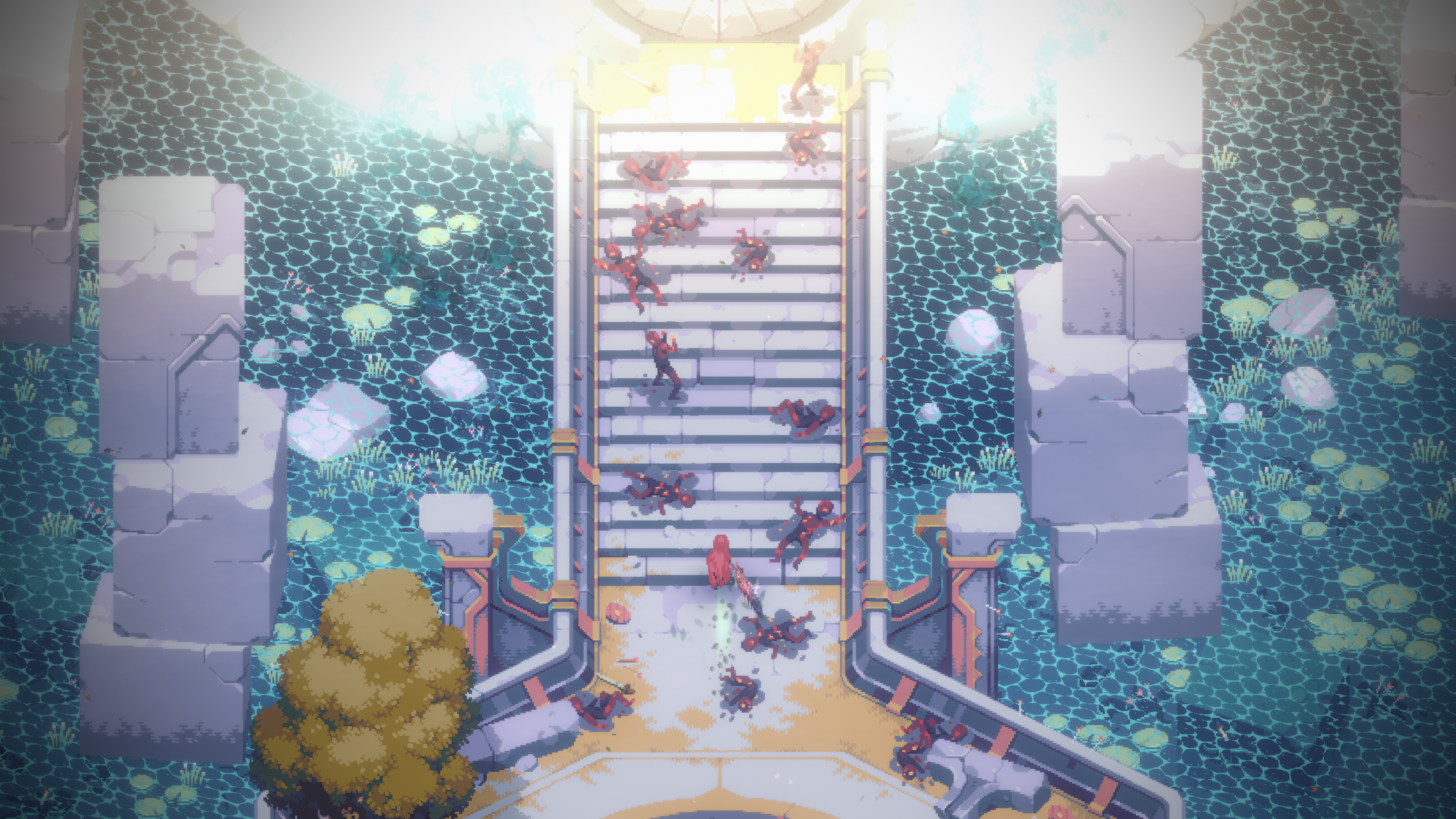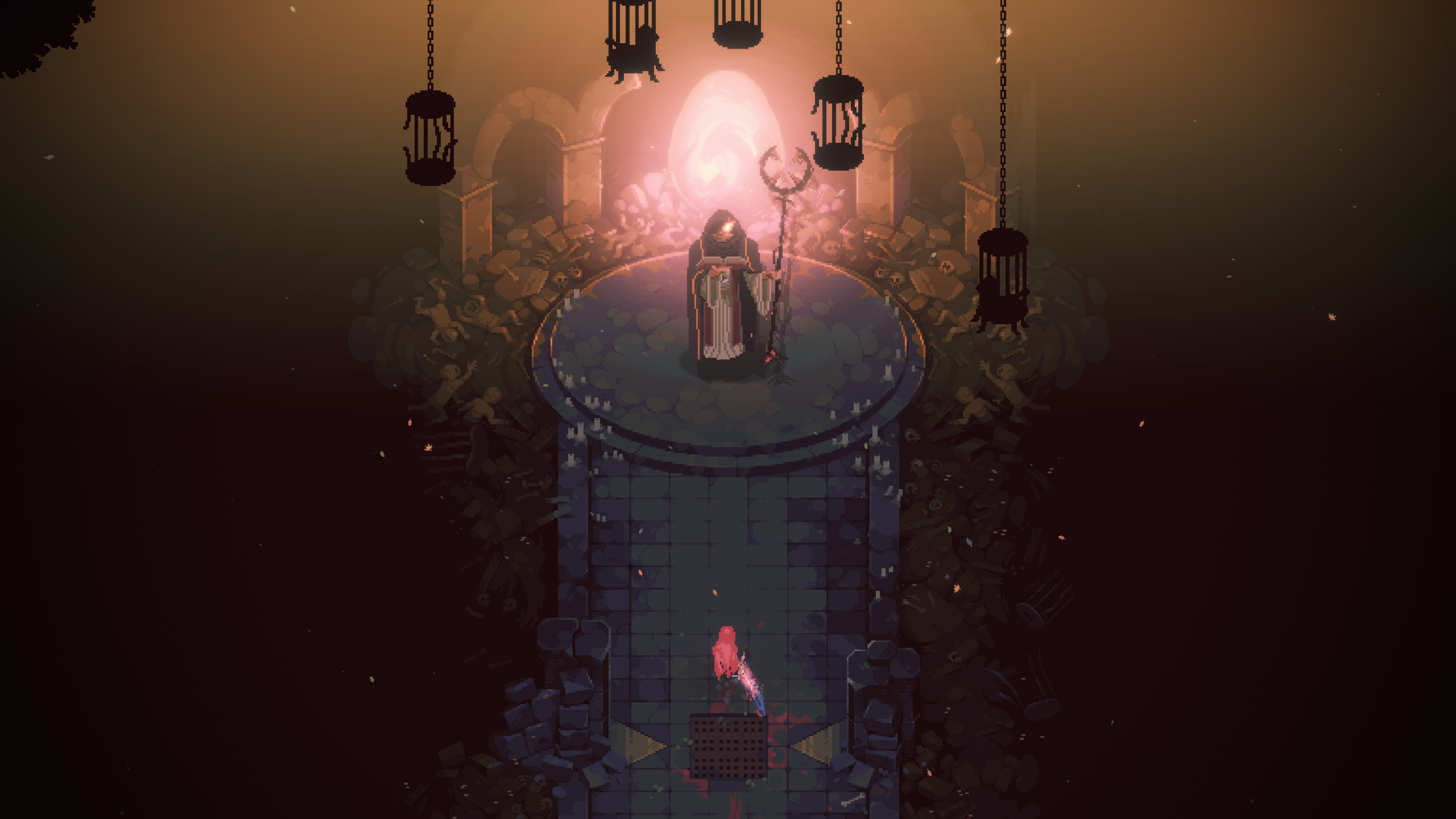A souls-like feels like a dime a dozen in 2021. Since 2011, the industry has been making games with deliberate, stamina-based combat with stern difficulty and vague lore elements in every form it can come in. Hearing that yet another is launching in late July of this year might not move your content flooded needle. I must insist you shake that compulsion for Eldest Souls, a game I spent some time with Fallen Flag Studios playing a couple of weeks ago.
Eldest Souls is a top-down action RPG of the gloomy pixel variety. Equal parts Hyper Light Drifter and cosmic horror monster simulator Sea Salt in mood, every step of Souls is drenched in dark mystery. Pixel art has come a long way from the early indie bubble that focused more on creating a style that was reminiscent of the old days instead embracing the format as a platform for new expressions, and Eldest Souls succeeds in feeling like the latter.
Unlike many souls-like games, Eldest Souls doesn’t control the pace by making the exploration a dangerous affair in and of itself. There are no environmental traps, hell, there aren’t even any minor enemies. Instead, they cut straight to the chase, plotting ten terrifying bosses around the world to take you to the controller-throwing limit. I met three during my hour with studio co-founders Francisco Barsotti and Jonathan Costantini, and they were a doozy.
The first boss, The Watchdog, served as a great way to get the basics of the combat down. It’s where I got up and running with the light/heavy attacks and learning the limits and risks of the dodge mechanic. “We obviously took inspiration from Souls games,” Jonathan told me, “But also more action-heavy games like Devil May Cry guided our action design as well.” There’s no enemy air juggling or corny one-liners, but the sharp and responsive action and necessity to make the most out of every opening are reminiscent of the Capcom classic when things are at its most hectic.

Unique to Eldest Souls is the “bloodburst attack,” a big swing that is empowered by filling your “bloodthirst gauge” (that you fill by landing charged up heavy attacks). When your thirst gage is full, your attacks are faster, do more damage, and actually heal you by a percentage of the damage you’re doing. The bloodburst attack spends that meter, but the big attack you trade it for does huge damage and is extremely vital to breaking through enemy defenses. Managing bloodthirst and bloodburst adds a rhythm to the standard hacking and slashing that you won’t find in any of Eldest Souls contemporaries.
Fighting styles add a wrinkle to the action. What your talent attack becomes is determined by your style. When you gain talent points, you can assign them down three different, World of Warcraft-inspired trees turning the attack into one of the following – Windslide, Berserk Slash, and Counter. I dabbled with each but I tended to lean on Counter, especially against the slower, more powerful second boss, Guardian. My charged attacks gradually built a blue, shield shaped gauge in the corner and when it was full, I could hit the right bumper just in time with the enemies attack to catch it and return damage back to them. Super useful when you have the rhythm of your enemy down.

Investing down each track opens up lots of passive boosts and abilities tied to the style that really adds depth and options. Counter eventually gains the ability to create passive swords that float around you and attack your enemies for you. These points can be refunded and reinvested at any time between battles, which ensures that you can switch your style up between bosses to evolve your gameplay with the growing difficulty. Counter worked wonders on The Guardian, but the next boss, Azekiel, was way too fast for me to make the most of it. A perfect time to switch to Windslide… and still get my face beat in.
Maybe my favorite feature are the boss shards, which you gain after slaying each titanic creature. These shards can be infused into different slots to grant different passive and active abilities or bonuses. Infusing the Guardian’s Corrupted Grasp shard into your active slot gives you a Legend of Zelda-style grappling hook that lets you traverse over gaps. Moving that same shard to your bloodburst attack makes the attack leave a smoldering trail behind it that does damage over time. Almost everything you do can be modified this way, and as you rack up the shards from each of the ten planned bosses, you start to realize the infinite customizability of your combat strategy. You can play this game 10 different times in 10 different ways and still have options you hadn’t considered yet.

The end product aims to launch with replayability in mind. A New Game+ mode is in the works, and it will do more than just make bosses hit hard. It’ll alter their patterns, switching out old moves with new moves, forcing you to relearn them again. An arena mode is also in the works, that would narrow the boss rush design even further, forcing you to fight each boss on the same map one after the other, without the benefit of upgrades and abilities. This is obviously for the hardest of hardcores. I’ll probably skip that, but I definitely won’t let Eldest Souls slip out of launch without me getting my hands on it.
Eldest Souls launches on all platforms on July 29th.






